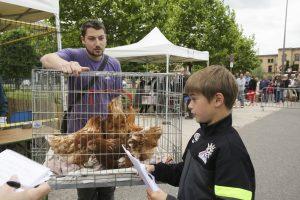Agglomération de Colmar : Chickens to reduce bio-waste
Claire Plouy, May 2019
As part of its local waste reduction plan, the Colmar urban community decided to provide a couple of chickens for the voluntary residents. The aim is to reduce some of the bio-waste collected by the community. But the initiative has many other impacts, particularly on the links between the inhabitants. Guy Waehren, vice-president of the Colmar agglomeration in charge of waste recovery and management answered questions from Territoires-Audacieux.fr.
What are you doing in the greater metropolitan area to reduce waste?
We have a local waste reduction plan. Since early 2012, we have a weekly home collection of bio-waste in all communities in the agglomeration community. This is the first major operation that we launched following the Grenelle Environment Round Table with the support of ADEME (French Environment and Energy Management Agency). This has led to better collection and sorting for all packaging. This is a political decision because we believe it is essential to sort and recycle rather than incinerate or bury it.
Can you tell me about your decision to provide chickens for your residents?

In 2015, under the initiative of the mayor of Colmar, Gilbert Meyer, we decided to launch this operation. At the very beginning, more than 200 homes offered to host hens. We offered two free hens per household. We did not provide a henhouse, it was up to the inhabitants to do so. However, we had to make sure that each home had enough space for the hens (between eight and ten square meters). This proposal mainly affects individual houses and small collectives that have common spaces. We had each household sign a charter, with the possibility of checking it on the spot. We wanted to make sure that no hens would be abandoned after a certain period of time. We know all the households that have taken chickens and there is a follow-up.
How did you set up this operation?
To set up this operation, we had to find the chicken suppliers. We currently have two suppliers: one who provides us with red hens and the other who provides us with black hens from Alsace. There are two distributions every year : one in May for the red hens and one in autumn for the black Alsatian hens.
Have you been able to measure the impact?
There are about 70 to 80 tons of organic waste that are disposed of this way every year. However, we currently collect 4,800 tons of it throughout the entire urban area (110,000 inhabitants). However, the operation is still going on and more and more households are taking it up. Most of them are satisfied. Every two years, they can ask for a new allocation of two free hens. At the end of 2018, we had about 1200 households with chickens. The new endowment is planned for May 25, 2010, for 220 new households.
What other benefits do these chickens get ?

Hens aren’t just used to eat bio-waste, they also make eggs. In addition, they create a neighbourhood bond. During the holidays, residents with chickens undertake to find a neighbour or family member to look after them. This builds relationships in the neighbourhoods.
What are some of the difficulties you may have encountered ?
We’ve had a few chickens killed by foxes. We’re a city but there are still some neighborhoods with houses more or less isolated from the center. So there is a possibility of predators in some places.
What is the cost of this initiative?
Each couple of chickens costs us €25. Within the framework of the local waste reduction plan, the urban community and the communes finance the hens. There are 20 communes in the conurbation, of which about 15 have been taking part in the operation since the beginning. We also have subsidies from ADEME for communication.